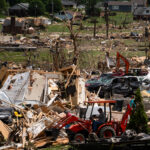Federal mining regulators cited a western Maryland coal operator Monday for failing to ensure the safety of two workers who died when the side of an open-pit mine collapsed in April, burying the men beneath 93,000 tons of rubble.
The Mine Safety and Health Administration said Tri-Star Mining Inc. of Barton failed to establish a safe ground-control plan in the area, which had been weakened by decades of underground mining. The agency also said a foreman’s examination of the area less than an hour before the collapse was inadequate and that the company hadn’t trained miners to recognize the hazards of surface mining over abandoned underground mines.
“The fatalities occurred because the ground-control plan did not adequately address highwall conditions, and obvious hazards were allowed to exist,” the 28-page report stated.
The amount of any fine will be determined by the agency’s Office of Assessments, MSHA said.
Tri-Star Mining President George R. Beener declined to comment when reached at his home in Rockwood, Pa.
Miners Dale F. Jones, 51, of Lonaconing, and Michael R. Wilt, 38, of Frostburg, died April 17 when the hillside they were mining, known as the highwall, collapsed on top of them, filling the pit with rocks and dirt, the report said.
Caledonia Hill contained underground mine works dating back to 1888, investigators found. Subsidence – the collapse of earth into the subterranean voids – had created instability characterized by surface cracks at the top of the highwall, investigators found.
The company’s plan for controlling the instability was inadequate, MSHA found. Not only did Tri-Star fail to put tiered “benches” along the face of the 250- to 275-foot highwall to catch falling rocks, as proposed in its 2002 plan, but the benches wouldn’t have been enough to prevent failure of the highwall, which the company described in its plan as averaging 125 feet, MSHA found.
Jones had told a mine foreman shortly after starting work at about 5:30 a.m. that rocks had fallen from the highwall, investigators found. The foreman, Raymond Tighe, inspected the highwall and found cracks near the top, but didn’t go into the pit where the victims were working. The wall collapsed 40 minutes to 50 minutes later, the report states.
“An adequate examination would have involved traveling to the pit floor active working area to ensure the pit was safe to work in,” the report said.
MSHA also faulted Tri-Star for failing to map the abandoned underground mines and failing to train workers on the hazards of subsidence.
Jones’s widow, Linda Jones, said after meeting Monday with MSHA officials that she holds the agency partly responsible for her husband’s death since an MSHA inspector had visited the mine eight days before the accident.
“My thing is, MSHA’s as much to blame as the employer,” she said. “I think I would have shut ’em down until they got a new ground plan.”
Jones and Wilt are among eight U.S. coal miners killed this year in mine accidents, according to MSHA.
Last year, 47 people – 24 of them from West Virginia – died in the nation’s coal mines. It was the highest death toll since 1995.
On the Net:
Mine Safety and Health Administration: http://www.msha.gov
Was this article valuable?
Here are more articles you may enjoy.

 SEC Dropping Enforcement Case Against Binance Crypto Exchange
SEC Dropping Enforcement Case Against Binance Crypto Exchange  Will Workers’ Comp Benefit from ‘Most-Favored-Nation’ Drug Pricing?
Will Workers’ Comp Benefit from ‘Most-Favored-Nation’ Drug Pricing?  DIY Home Inspections? They Are Taking Over, Firms Say
DIY Home Inspections? They Are Taking Over, Firms Say  Trump Administration Targets Resiliency Funds to Shrink FEMA’s Role
Trump Administration Targets Resiliency Funds to Shrink FEMA’s Role 